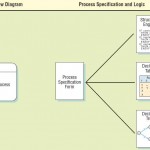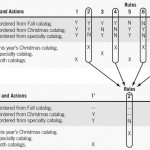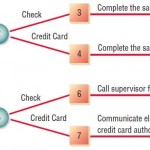The systems analyst approaching process specifications and structured decisions has many options for documenting and analyzing them. In Chapters "Using Data Flow Diagrams" and "Analyzing Systems Using Data Dictionaries" you noted processes such as … [Read more...] about Process Specifications and Structured Decisions
Process Specifications and Structured Decisions
Overview of Process Specifications
To determine the human information requirements of a decision analysis strategy, the systems analyst must first determine the users’ objectives, along with the organization’s objectives, using either a top-down approach or an object-oriented … [Read more...] about Overview of Process Specifications
Process Specification Format
Process specifications link the process to the data flow diagram, and hence the data dictionary, as illustrated in the Figure 1 below. Each process specification should be entered on a separate form or into a CASE tool screen. Enter the following … [Read more...] about Process Specification Format
Writing Structured English
When the process logic involves formulas or iteration, or when structured decisions are not complex, an appropriate technique for analyzing the decision process is the use of structured English. As the name implies, structured English is based … [Read more...] about Writing Structured English
Developing Decision Tables
A decision table is a table of rows and columns, separated into four quadrants, as shown in the table illustration below. The upper left quadrant contains the condition(s); the upper right quadrant contains the condition alternatives. The lower half … [Read more...] about Developing Decision Tables
A Decision Table Example
Table below is an illustration of a decision table developed using the steps previously outlined. In this example a company is trying to maintain a meaningful mailing list of customers. The objective is to send out only the catalogs from which … [Read more...] about A Decision Table Example
Drawing Decision Trees
Decision trees are used when complex branching occurs in a structured decision process. Trees are also useful when it is essential to keep a string of decisions in a particular sequence. Although the decision tree derives its name from natural trees, … [Read more...] about Drawing Decision Trees



